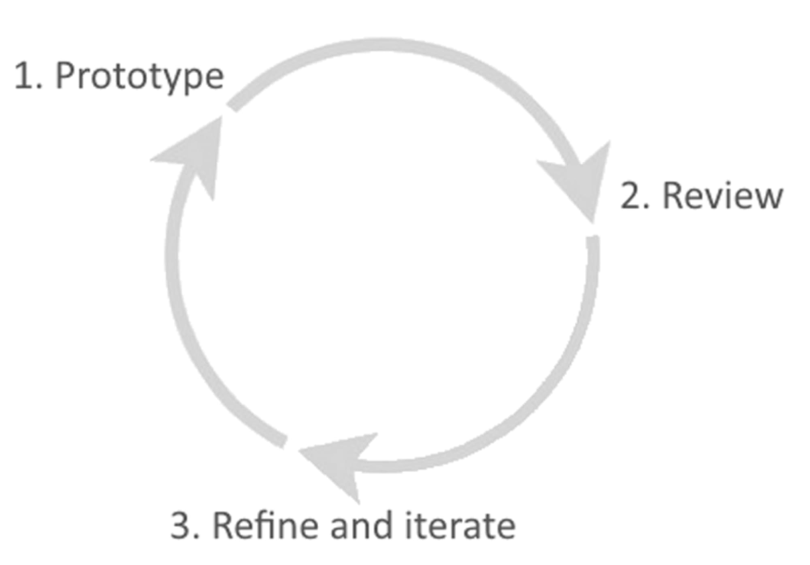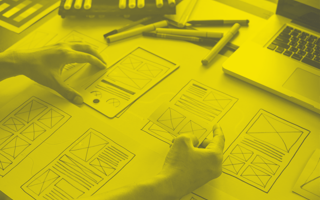When it comes to building great products, design is the most important feature. It’s what sets companies apart and gives them a competitive advantage. But how do you create great design? The answer is simple — when designing products, always remember that you are designing for people.
In this article, I’ll focus on design thinking, an approach that will help you to design great products.
What Is Design Thinking?
Design thinking is simply an approach to problem-solving. It’s focused on understanding people’s needs and discovering the best solutions to meet those needs. The most significant difference between this approach and traditional methods of product design is that, in this method, the design process always begins with understanding users. This understanding better positions the team to create a successful design.
The design thinking model was initially developed by the Hasso-Plattner Institute of Design at Stanford University and popularized by the design agency IDEO. Design thinking is a human-centered approach to design that takes the needs of users and the possibilities of technology to create a solution that is well-aligned with both users and business goals.
How It Works
Design thinking reinforces a design process, organized as a series of steps that product teams follow during the formulation of a product from start to finish. A product team that uses a design thinking approach attempts to find a solution to their problem by following these five steps:
- Empathize
- Define
- Ideate
- Prototype
- Test
1. Empathize
Empathy is an essential ingredient of product design. Products are used by people, and it’s important to start the design process by learning about the people for whom you are designing. At this stage, product designers should conduct research to develop a deeper understanding of their target audience. To update an old saying, time spent researching is never time wasted. Good research informs your product design. When it comes early in the design process, research will save you a lot of resources, both time and money, down the road because you’ll need to make fewer adjustments later.
The best way to start a process is by conducting a series of interviews. Gathering information through direct conversation with people who represent your target audience is a well-known research technique that can give you rich information about users. This technique can help the researcher assess not only the user’s wants and needs, but also their feelings. The emotions that users feel when they interact with a product have a significant impact on their experience. Products that elicit positive emotional reactions have a better chance to stay in use and extend their life cycle.
2. Define
At this step, you need to identify key user groups who might all use your product in a similar way, also known as personas, and the problem that they face. In user-centered design, a persona is a fictional character created to represent a user type. Personas are useful in considering the motivations and goals of users in order to help to guide decisions about a product or service.
After you identify your key personas, try to define a problem using a problem statement. Your problem statement is your key to a successful solution because it will help you to identify the gap between the problem itself (user needs) and the goal you want to achieve with your design (your solution). While there are a few different approaches for writing product statements, UX designers often describe the desired or “to be” state of the product created based on the goals of the stakeholders and customers. As a whole, this statement illustrates what the expected experience will look like once the solution is implemented. For example, if you wanted to design a food ordering app for Millennials, you could state the problem as “Help Millennials who want to explore various cuisines to find and order food they will love in five minute or less.” Note that the problem statement is action-oriented: it focuses on end-users’ problems and makes you prioritize your efforts to meet their expectations.
Job stories are a useful technique for defining a problem without being prescriptive of a solution. They can help you to map out the key aspects of the future product: what it is, who it’s for, and when and where it will be used. To create a job story, the product team frames a user problem in this format: When _____, I want to _____, so I can _____. For example, when I find a food I like, I want to spend the least possible amount of time ordering it, so that I continue doing other activities.
Last but not least, the product team needs to interview stakeholders to define business goals and objectives for the project such as expected revenue or the total number of acquired users. By matching user needs to business goals, you’ll be able to find a sweet spot of product design.
3. Ideate
At this stage, the product design team brainstorms a range of solutions and selects the one or few that best solve the problem.
“How might we” is one helpful tool for this stage. When a team uses this technique, it usually starts with a high-level question, such as “How might we design a food ordering app for Millennials?” The team then narrows down the focus to particular parts of the user interface by asking specific questions like “How can we design an aesthetically pleasing checkout page?” This strategy empowers the product team to create as many solutions for the problem as possible, evaluate solutions together, and pick the one that works the best.
Product teams should also try to visualize their ideas. Sketching is one of the most useful techniques for that. It helps team members to visualize how some aspects of the future design, such as individual pages or screens, will look.
Storyboarding is another technique that allows a team to visualize a potential user’s interactions with a product. A storyboard is a linear sequence of illustrations arranged together to tell a story. This tool can help a product team team to visually explore a theoretical user’s experience with a product and predict problems.
4. Prototype
There are two types of ideas: good ideas that lead to product success and bad ideas that can lead to failure. A bad idea, even if well-executed, is a big waste of time and energy. To ensure an idea is good, just coming up with a solution to a problem isn’t enough. It’s also vital to ensure that it will work for your users. Creating a prototype helps designers understand whether they are on the right track or not.
A prototype is an experimental model of an idea that enables you to test it before building the full solution. They can range from rough sketches on a piece of paper (low-fidelity prototypes) to interactive simulations that look and function like a real product (high-fidelity prototypes). The appropriate prototyping technique depends on the maturity of your idea and the goals of the prototype. Remember that a major goal of this step is minimizing the time required to create the prototype without sacrificing learning. One of the most efficient prototyping processes to achieve this is rapid prototyping, which is a cycle with three stages:

- Prototype: Create a prototype as fast as possible (do not invest in polishing visual or interaction design details).
- Review: Give your prototype to users and stakeholders and gather feedback from them. Understand what works well and what does not.
- Refine and Iterate: Based on feedback, identify areas that need to be refined or clarified. The list of refinements will form the scope of work for your next design iteration.
5. Test
The testing phase helps a product team ensure that the design concept works as intended. Based on the results of testing, the product team might want to introduce changes to the original solution. Thus, it often leads to another iteration of the product design.
Usually, the testing phase starts when the high-fidelity design, meaning that it looks and works almost like a finished product, is fleshed out. High-fidelity prototypes can be tested in-house by the team members themselves, or a product team can invite a small number of users who represent their target audience (as few as five users can be enough) to interact with a prototype.
Let’s briefly discuss the design techniques and start with internal testing. A technique known as dogfooding (“Eating your own dog food”) is a popular way of internal testing. The term comes from an email entitled “Eating Our Own Dogfood” that Microsoft manager Paul Maritz sent to his colleagues to encourage them to increase internal usage of the company’s product. Once the design team has iterated on the product to the point where it’s usable, testing it internally is a great way to find the most critical issues. Dogfooding also helps team members to develop empathy to their users.
When it comes to testing with real users, the product team often relies on usability testing to validate their design. The basic idea behind a usability test is to check whether the design of a product works well with the target users. It’s relatively easy to test a concept with representative users: once an interactive version of a product idea is in the hands of real users, a product team will be able to see how the target audience interacts with the product and what issues they face. Based on that information, the team can modify the original concept. Teams can conduct usability testing formally in a lab setting where a researcher creates a screener, hires participants, invites them into the lab environment, and records the session. Alternatively, the team can carry out testing via informal guerrilla testing. In this type of test, a product tester goes to the nearest coffee shop, finds participants, asks them to play with a product for 10 minutes, and then gives them a small treat as a thank you. Formal, in-lab testing is more suitable for the later stages of product design when you have a high-fidelity prototype and want to get more specific feedback on design decisions. Conversely, guerrilla testing is more suitable for testing low-fidelity prototypes when a team just wants to know if their key design decision is valid or not before investing time and effort in building something more advanced.
The most important thing to remember when designing products is that you must deliver the right features, with the right user experience for the right people. The design thinking approach will help you to define your target audience, research their problems, focus on building a product that solves those problems, and finally validate your product by testing it with real users.





